All eyes are on the rumbling Mount Mayon, a perfectly cone-shaped volcano that could spew its dangerous contents at any moment.
By Heather Brady
WHY IS THE VOLCANO IN THE PHILIPPINES EXTREMELY DANGEROUS?
The most active volcano in the Philippines is well known for its perfect cone shape—which actually signals how dangerous the volcano can be. Its geology and location could soon combine in explosive, and deadly, fashion.
Mount Mayon, which is located on the big island of Luzon, has been spewing ash, rocks, and mud since January 13 as it prepares to erupt in what is expected to be a big way. On Monday, the Philippine Institute of Volcanology and Seismology raised the alert level to four out of five possible levels, meaning a sizable eruption could happen at any moment.
The alert went out after a loud explosion was heard, indicating high activity. Previous eruptions, like in 2006 and 2009, simply oozed lava from the mouth of the volcano, with small intermittent explosions. The last explosive eruption happened in 2001 and sent ash spewing six miles into the sky.
Picture of a volcano erupting in the Philippines
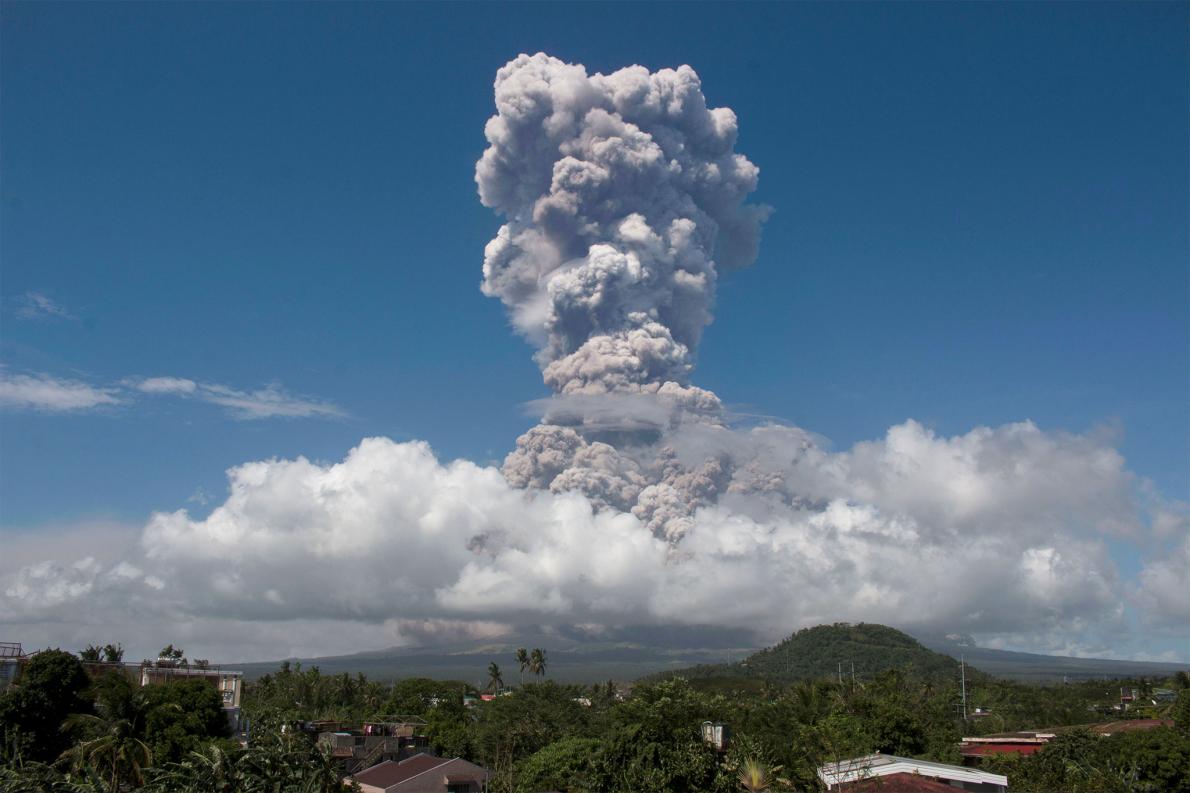
PHOTOGRAPH BY EARL RECAMUNDA, AP
A huge column of ash shoots up to the sky during an explosion from the Mayon volcano, about 200 miles southeast of Manila, Philippines.
Mount Mayon is known for its steep-sloped cone. The Smithsonian reports (https://www.smithsonianmag.com/science-nature/how-geology-makes-mayon-volcano-beautiful-and-dangerous-180967897/) that the volcano’s picturesque symmetry makes it something of a tourist attraction, with climbers trying to get to its rim.
But it is precisely this dramatic shape that indicates how frequent the volcano erupts. Since Mayon’s first recorded eruption, in 1616, it has erupted about 58 times, ranging from sputters to calamities. Four of those eruptions have happened in the last decade, according to the Smithsonian. In 1814, when Mayon exploded, it sent ash several miles into the sky, killing 1,200 people.
Many of Mayon’s eruptions have involved spraying out lava that collects at the rim. As it sputters over the top, it builds up over time, causing the steep slopes that have made it famous.
DANGEROUS ANALOGS
For comparison, Mount Vesuvius (https://www.nationalgeographic.com/magazine/2007/09/vesuvius-volcano-dormant-eruption-pompeii/) (the Italian volcano of Pompeii https://video.nationalgeographic.com/video/news/160802-pompeii-mysteries-revealed?_ga=2.80141267.535036252.1516840511-1329777776.1516840511 fame) has also erupted over 50 times http://www.history.com/topics/ancient-history/pompeii in recorded history. The famous eruption that killed 2,000 people and preserved the city of Pompeii for hundreds of years under many tons of volcanic ash unfolded in much the same way—explosions, ash raining down, air so thick that it’s hard to breathe, and then finally a pyroclastic flow.(https://news.nationalgeographic.com/news/2013/12/131219-benjamin-andrews-model-volcanoes-pyroclastic-flows-earth-science/)
That flow, or surge—an explosive blast that sends ash, lava, and volcanic gas raining down fast onto the sides of the volcano—is the most dangerous part of an eruption. It’s what buried Pompeii, and Mayon may erupt in a similar fashion.
IMAGES OF VOLCANOES AROUND THE WORLD
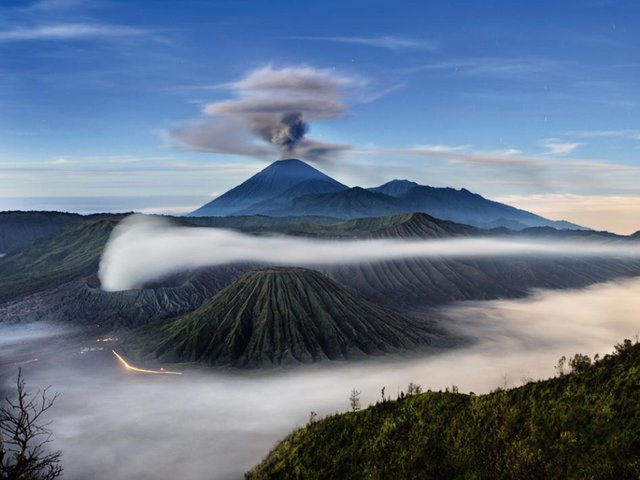
- PHOTOGRAPH BY JOHN STANMEYER, NATIONAL GEOGRAPHIC
Mount Semeru, seen with an ash plume, is the highest volcano on the Indonesian island of Java and has been in a constant eruption since 1967. It lies at the southern end of the Tengger caldera, which contains smaller volcanoes
Mount Bromo and Mount Batok (both seen in the foreground), and several others.
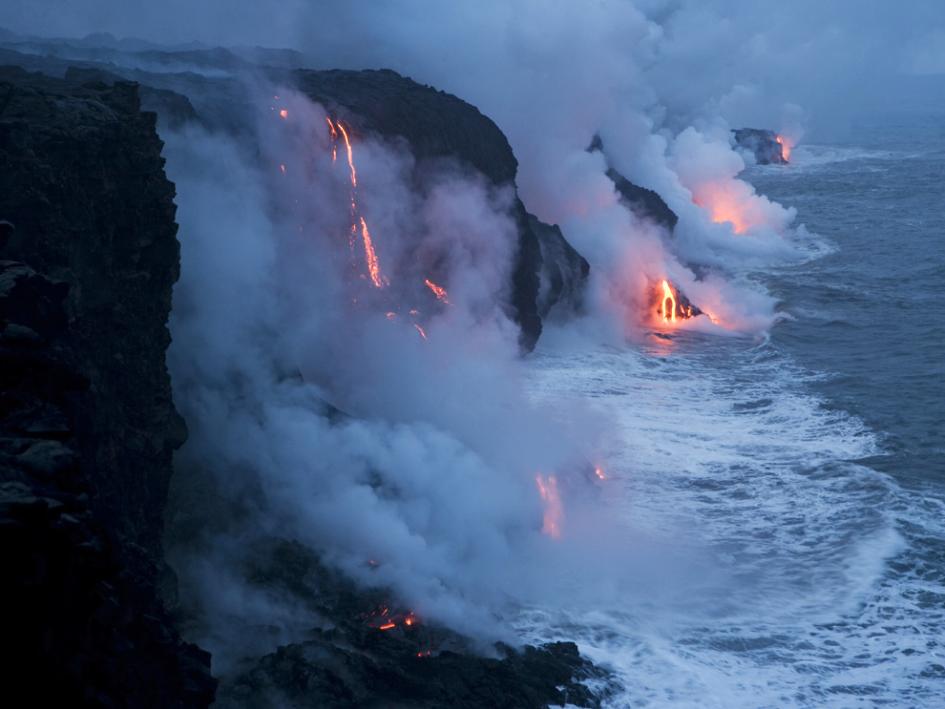
- PHOTOGRAPH BY STEPHEN ALVAREZ, NATIONAL GEOGRAPHIC
With a hiss of steam, lava flows into the Pacific Ocean in Hawaii Volcanoes National Park, Hawaii. Similar flows of molten rock have built up the Hawaiian islands over the course of more than 70 million years.
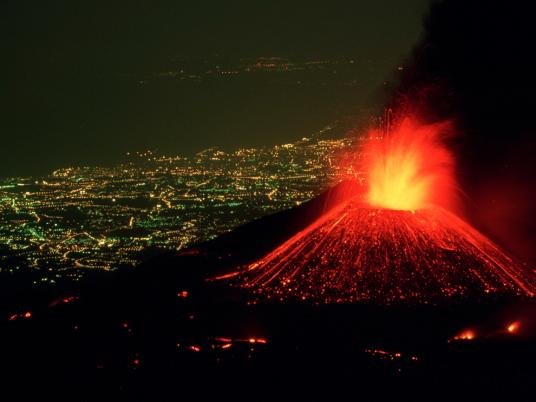
- PHOTOGRAPH BY CARSTEN PETER, NATIONAL GEOGRAPHIC
Perched above the lighted city of Catania, Italy, Mount Etna hurls a fountain of fire skyward as rivers of lava spill down its flanks. In spite of its dazzling displays, Mount Etna is a relatively safe volcano with rare, compact eruptions and slow-flowing lava that gives people a chance to escape.
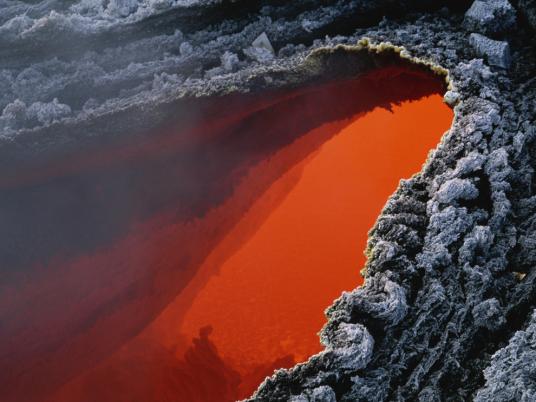
- PHOTOGRAPH BY CARSTEN PETER, NATIONAL GEOGRAPHIC
A few hundred degrees separates this pool of fiery orange magma in Italy’s Mount Etna from its hardened, gray crust. At nearly 11,000 feet (3,353 meters), Mount Etna is Europe’s highest active volcano.
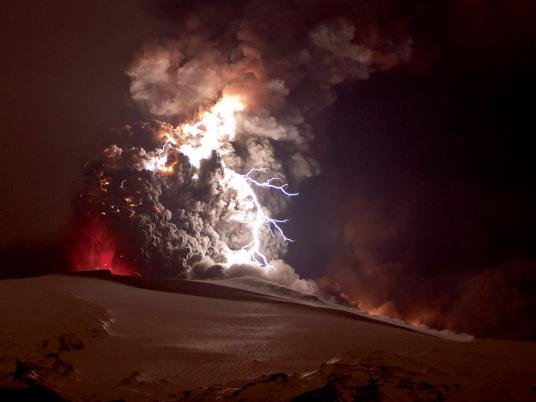
- PHOTOGRAPH BY PETER VANCOILLIE, YOUR SHOT
A bright bolt of lightning crackles within the ash cloud from the eruption of the Eyjafjallajökull volcano in Iceland in April 2010. Volcanic lightning occurs when roiling ash particles rub against each other and become electrically charged.
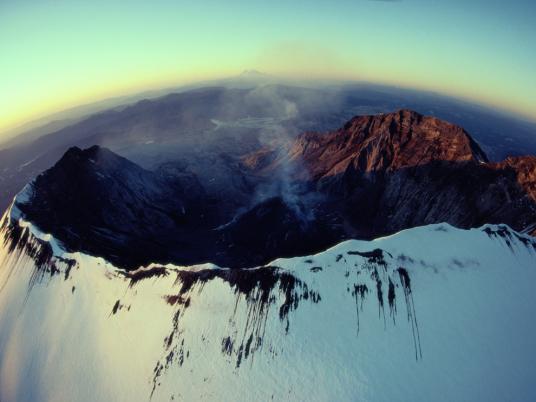
- PHOTOGRAPH BY STEVEN L. RAYMER, NATIONAL GEOGRAPHIC
A wisp of smoke escapes from Mount St. Helens’ dramatic eggshell-shaped crater after an eruption. Washington State’s volcano is most famous for its catastrophic 1980 eruption that killed 57 people, destroyed homes, bridges, and highways, and triggered an enormous debris avalanche that carved a mile-wide (1.6-kilometer-wide) crater on the mountain.
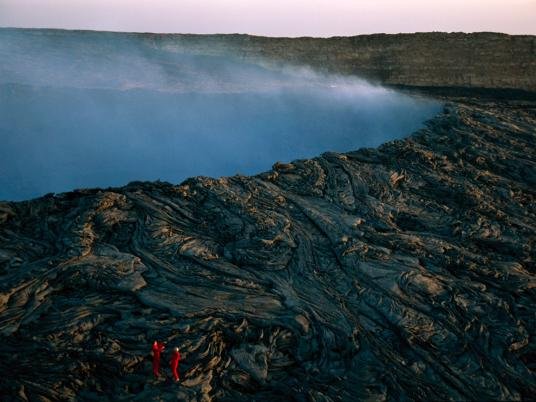
- PHOTOGRAPH BY CARSTEN PETER, NATIONAL GEOGRAPHIC
Climbers mount whorls of lava on the caldera of Ethiopia’s Ertale Volcano as steam escapes from a lava lake in the volcano’s crater, which can reach temperatures of 1,868°F (1,020°C).
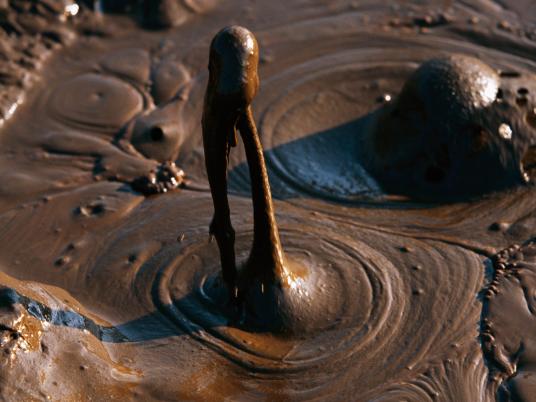
- PHOTOGRAPH BY CARSTEN PETER, NATIONAL GEOGRAPHIC
A pool of mud boils near Dallol Volcano, in Ethiopia’s remote Danakil Depression. Volcanic explosion craters such as Dallol form during phreatic eruptions—where rising magma comes into contact with water beneath the surface of the Earth, causing a steam explosion.
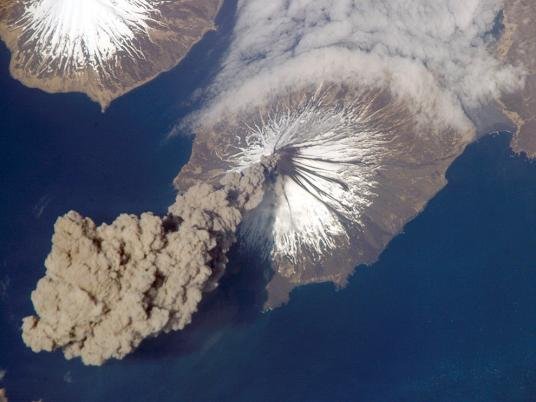
- PHOTOGRAPH COURTESY NASA EARTH OBSERVATORY
Cleveland Volcano releases a plume of ash that rises almost 20,000 feet (6,000 meters) above the North Pacific Ocean in this aerial photograph. Cleveland Volcano, located in the Aleutian Islands southwest of Alaska, failed to produce an eruption and the plume of ash detached from the volcano two hours after it formed.
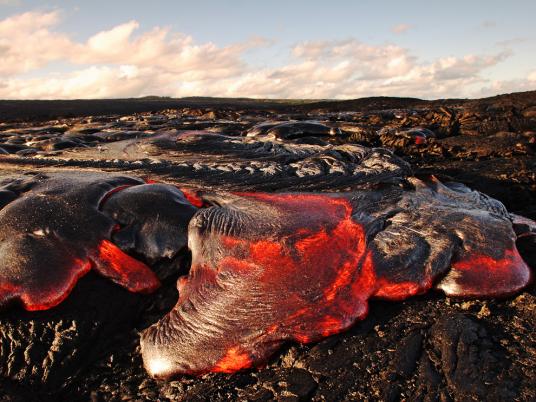
- PHOTOGRAPH BY STEVE AND DONNA O'MEARA, VOLCANO WATCH INTERNATIONAL/NATIONAL GEOGRAPHIC
Pahoehoe lava flows on Kilauea volcano in Hawaii Volcanoes National Park. Unlike aa (pronounced “ah ah”) lava, pahoehoe flows relatively slowly, allowing an insulating skin to form that keeps the temperature close to 2,190°F (about 1,200°C). Aa lava, on the other hand, moves faster and doesn’t have time to develop a skin, resulting in a cooler flow with a more angular texture.
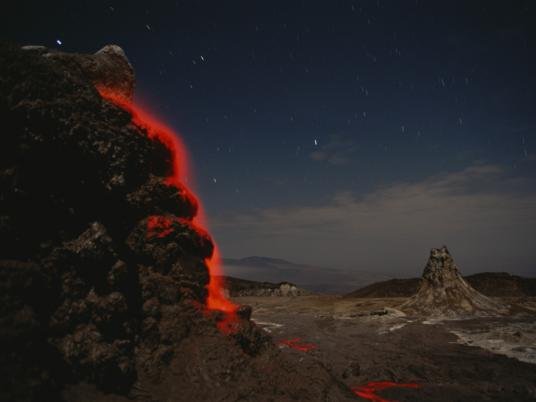
- PHOTOGRAPH BY CARSTEN PETER, NATIONAL GEOGRAPHIC
A stream of neon-orange lava cascades down Ol Doinyo Lengai, in Tanzania’s Great Rift Valley. Ol Doinyo Lengai, "Mountain of God" in the language of the Maasai, is the only volcano in the world erupting natrocarbonatite lava, an extremely fluid lava that contains almost no silicon.
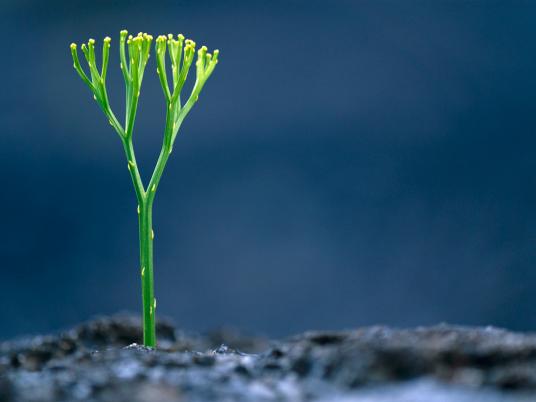
- PHOTOGRAPH BY FRANS LANTING, NATIONAL GEOGRAPHIC
A whisk fern grows from recently cooled lava in Hawaii Volcanoes National Park, Hawaii. Plants can return rapidly to areas affected by volcanic eruptions. Over time, lava and ash break down to form fertile soils ideal for agriculture.
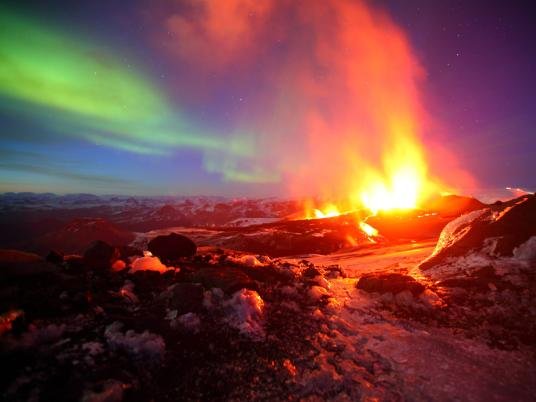
- PHOTOGRAPH BY JAMES APPLETON, YOUR SHOT
A volcanic eruption and the eruption of light from charged particles in the atmosphere—called the Northern Lights—occur at the same time in Iceland. The island nation was created by volcanic activity and today has 35 active volcanoes, which provide the country with plentiful geothermal power.
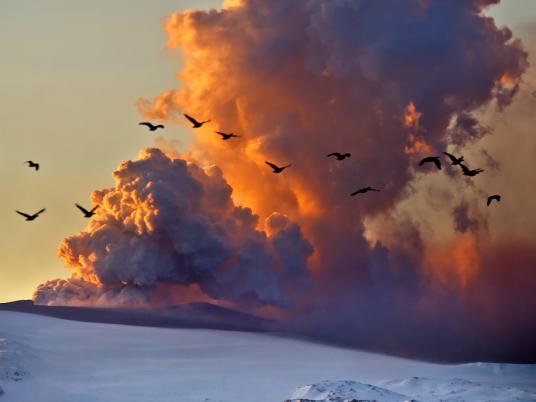
- PHOTOGRAPH BY SNORRI GUNNARSSON, MY SHOT
Geese fly past the ash cloud from the eruption of the Eyjafjallajökull volcano that began in April 2010. Ash from the volcano disrupted air traffic in Europe for more than a month.
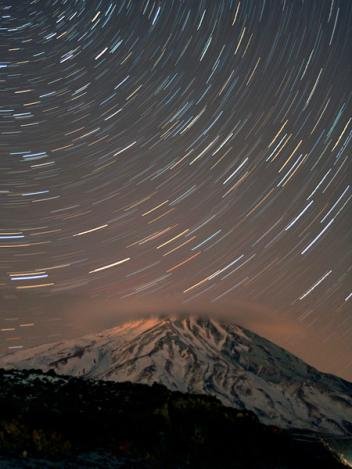
- PHOTOGRAPH BY SIAMAK SABET, YOUR SHOT
Stars whirl in the sky in a long-exposure photo of Mount Damavand in Iran. The mountain, which is part of the Elburz mountain range south of the Caspian Sea, is the highest volcano in Asia and the highest peak in the Middle East.
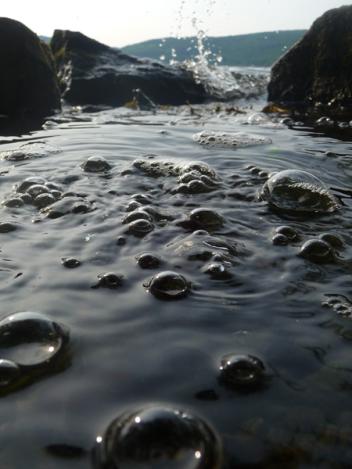
- PHOTOGRAPH BY HANNAH BAUMERT, MY SHOT
Gas bubbles up from the bottom of Laacher See (or Lake Laach) in Germany. A violent prehistoric eruption caused the Earth's crust to collapse and form a crater that filled with water. The lake lies in an area of Western Germany called the Eifel volcanic field.
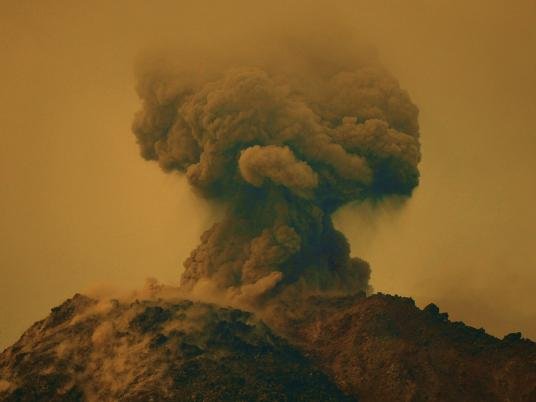
- PHOTOGRAPH BY LAWRENCE SMITH, MY SHOT
The Arenal Volcano in Costa Rica erupts suddenly in February 2010, turning the sky an ominous yellow-brown. The volcano is one of the most active in the world.
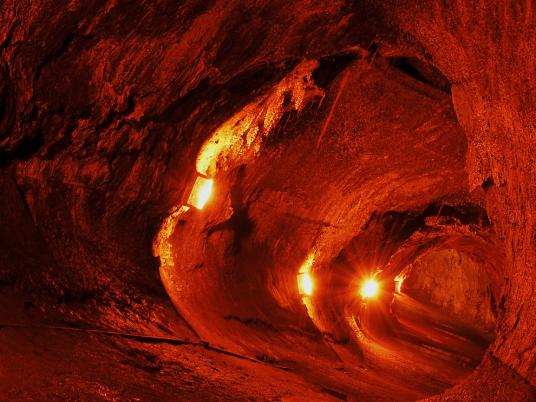
- PHOTOGRAPH BY KEVIN HAZELTON, MY SHOT
Lights illuminate the Thurston Lava Tube in the Hawaii Volcanoes National Park. Lava tubes serve as underground pipelines, allowing molten rock to flow under and away from volcanoes.
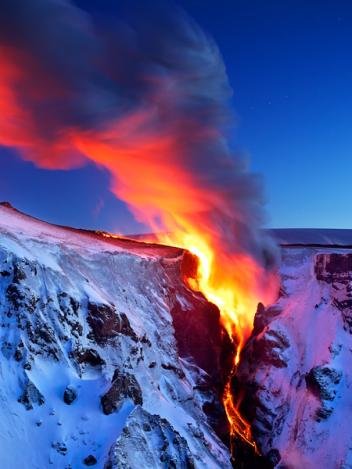
- PHOTOGRAPH BY SNORRI GUNNARSSON, MY SHOT
Lava flows into a valley in southern Iceland near the Eyjafjallajökull volcano.
TAKING PRECAUTIONS
For this eruption, the government has evacuated more than 34,000 people who live in the centrally located Albay province that houses the volcano, the Washington Post reports(https://www.washingtonpost.com/news/capital-weather-gang/wp/2018/01/22/the-most-active-volcano-in-the-philippines-could-be-on-the-verge-of-a-major-eruption/?utm_term=.b1768f2b7513). Not everyone who was evacuated lives close to the volcano, but many families could be affected by the mud flow (or lahar (https://news.nationalgeographic.com/news/2014/02/140214-mount-kelud-volcano-eruption-indonesia-ash-science/)) that may be created from the contents of the volcano mixing with heavy rains—the kind that the Philippines often receives.
Mayon is located on the Ring of Fire (https://www.nationalgeographic.com/science/earth/ring-of-fire/), the chain of volcanoes that sits along the edge of the Pacific Ocean. There are several subduction zones (http://www.ldeo.columbia.edu/~djs/aleut/info_for_public.html) of various ages colliding slowly together near the Philippines, so volcanic activity is frequent there.
Because the magma under a volcano is constantly shifting, it is difficult to predict the exact details of an eruption. However, given Mayon’s history and the activity it has shown this month, a dangerous and deadly explosion is a distinct possibility.
VOLCANOES 101
video.nationalgeographic.com/video/101-videos/volcanoes-101
- Volcanoes are as dangerous as they are majestic. Over 50 eruptions rock our planet every year. This video helps you understand what causes volcanoes to form and erupt—and shows where they are most likely to be found.
source:
https://news.nationalgeographic.com
.gif)
I just want to share this news from national geographic channel about how dangerous mt mount mayon's state.
Keep safe my fellow countrymen.
Hi! I am a robot. I just upvoted you! I found similar content that readers might be interested in:
http://enginercafe.blogspot.com/2015/07/top-surprised-volcano-photoimage-in.html
Downvoting a post can decrease pending rewards and make it less visible. Common reasons:
Submit